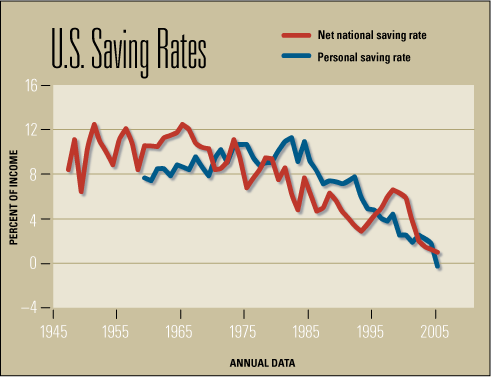As Household Asset Values Rise, Should We Still Worry about the Saving Rate?
The Commerce Department recently reported that the U.S. personal saving rate was -0.4 percent during 2005, continuing a long-term decline.1 Broader measures of saving, such as the net national saving rate, show the same downward trend during recent decades.2 (See chart.)
Meanwhile, the Federal Reserve reported that U.S. households’ assets minus their liabilities increased by almost $3.9 trillion during 2005.3 To put these reported wealth gains into perspective, disposable personal income was $9.25 trillion during 2005; so, the increase in net assets was equivalent to almost 42 percent of disposable personal income during the year. In fact, the average increase in household net assets from 1995 to 2005 was more than 35 percent of annual disposable personal income despite the crash of the stock market during 2000-02. The net value of residential real estate—owners’ equity, or the difference between residential real-estate values and the associated mortgage debt—increased by about $6.8 trillion during 1995-2005, while households’ total equity holdings increased by $12.1 trillion.
Should we worry less about declining saving rates in the United States because measured household net assets have increased so much? The answer is no, for two reasons. First, these commonly cited measures of personal saving and personal finances, respectively, are not directly comparable. Second, both of these measures provide incomplete pictures of the prospects for the economy. When we focus on the national, rather than personal, saving rate and make adjustments to the household asset and liability measures to make them more comprehensive, the previously contradictory implications of the saving and financial indicators vanish. After extending and reconciling the two measures, their message is the same—namely, that we do not appear, as a nation, to be putting aside enough resources today to ensure continued growth of prosperity at the pace to which we have become accustomed.4
Our current ability to borrow savings from abroad in order to invest domestically at a higher rate than otherwise would be possible does not change this conclusion, either. Borrowing today—whether by a household, a firm, the government or the nation as a whole—merely postpones and increases the need for saving in the future. Whether it takes place now or later, domestic saving ultimately is required to fund all of the domestic investment we undertake. If foreign savings are borrowed today, future domestic saving must be even higher in order to repay both principal and interest on the loans.
Reconciling the (Apparent) Conflict between Saving and Asset Trends
All measures of U.S. saving—household, business, government and national, as well as gross and net—generally have declined during the past few decades. Low or declining saving rates can harm future economic growth because fewer resources are being set aside for replacement and extension of the economy’s capital stock.
Meanwhile, many measures of net assets have increased, particularly during the past decade. Taken at face value, this means that the value of future economic output that can be produced with the capital stock has increased.
To be comparable, the saving rate and total wealth should be measured on the same basis, namely, for the national economy as a whole. One also must construct a comprehensive measure of wealth by extending the national balance sheet to capture explicit and implicit future transactions that are not usually incorporated.
Extending the scope of each measure to the national level eliminates several accounting inconsistencies. For example, the household saving rate does not capture changes in the economy’s capital stock created by corporate saving, even though the household sector owns the corporate sector. Meanwhile, the household-wealth measure reflects households’ ownership of the corporate sector (equity holdings), but it does not reflect the resulting zero-sum nature of debt securities owned by the household sector but which are owed to households by the business or government sectors. Households ultimately are responsible for repaying those debts (to themselves!) by virtue of their ownership of all businesses and by virtue of their obligation to pay all taxes, whether labeled personal or business.
The second reconciliation step requires both economic and accounting intuition. The basic issue is that common measures of household wealth, such as the household balance sheets contained in the Federal Reserve’s flow of funds accounts, are incomplete and are a mixture of historical-cost and market-value accounting.5 The result is that the accounting statements are partly backward-looking and partly forward-looking, with some important assets and liabilities missing altogether.
For example, residential mortgage-backed securities (RMBS)—of which there were $3.5 trillion in face value outstanding at the end of 20056—appear as liabilities of the securitizing firms at book (historical) value, while they appear in the asset portfolios of financial firms and households at market (forward-looking) value. But the residential mortgages underlying the securities obviously are liabilities of households; so, a household that owes $100,000 on a mortgage that has been securitized, while holding RMBS with face value of $100,000 and market value of $105,000, will show a completely spurious addition of $5,000 to wealth resulting solely from the internally inconsistent accounting treatment. Indeed, much of the $26 trillion of debt issued by domestic non-financial sectors is accounted for in this inconsistent way in most current frameworks.
The case of household tangible assets, such as residential real estate and automobiles, represents another instance of internally inconsistent accounting. As noted above, the recorded value of households’ net housing assets increased by almost $7 trillion during 1995-2005. At the same time, however, the cost of using that housing stock—what economists call the flow of future housing services—increased by precisely the same amount.7 In other words, on a comprehensive balance sheet that captures both the current value of the housing stock as an asset and the cost of purchasing the future flow of housing services it will provide as a liability, the net value of the housing stock on a national long-run basis is zero! The same is true for all other household tangible assets, as well.
Two other notable omissions from commonly cited measures of net wealth are “human capital,” or the present value of future earnings from work, and future outlays on a range of items including basic living expenses, discretionary purchases, insurance premiums and pension contributions, taxes and many more. It certainly is true that both human capital (a household asset) and future outlays (household liabilities) are difficult to measure with any precision. This does not justify excluding them from a comprehensive framework for analyzing financial resources and obligations, however.
As an example of a significant unrecorded future obligation, consider future taxes. The flow of funds accounts record almost $40 trillion of financial assets at the end of 2005, but this number greatly overstates the amount of goods and services that households could purchase with these assets. This is because trillions of dollars of taxes will be paid as the assets are distributed from retirement accounts, sold in the market or held as interest- or dividend-paying investments.
The Bottom Line: Rising Household Asset Values Do Not Substitute for Saving
So what about the reported increase in value of households’ assets minus their liabilities—equivalent to 42 percent of disposable income during 2005? Much of this “wealth gain” was the result of incomplete accounting. For example, appreciated housing values actually are canceled by the unrecorded, but very real, increased cost of living in the houses. Another portion of increased household assets corresponds to changes in the prices of stocks, which go up and down much more from year to year than the underlying economic value of the capital stock they represent.8
The dismal conclusion of this exploration of saving and wealth concepts is that, while neither the personal saving rate nor the flow of funds measure of household net wealth is perfect, the long-run declining saving trend probably better represents the underlying economic reality. Rising household asset values by themselves provide an incomplete and misleading picture and should not encourage us to ignore the danger signal associated with low rates of saving and investment in our future prosperity.
Endnotes
- The personal saving rate is defined as personal saving divided by disposable personal income. [back to text]
- The net national saving rate is defined as net saving of all sectors divided by national income. [back to text]
- "Flow of Funds Accounts of the United States," Federal Reserve Statistical Release Z.1, March 9, 2006. [back to text]
- See Kliesen (2005). [back to text]
- This criticism applies more broadly to Generally Accepted Accounting Principles (GAAP), not just to the flow of funds accounts. Indeed, a major focus of the Financial Accounting Standards Board (FASB) today is to explore the feasibility of converting GAAP to a full market-value basis (or what is more commonly termed “fair-value accounting,” because market prices are not always available or reliable). [back to text]
- “Flow of Funds Accounts of the United States,” March 9, 2006. [back to text]
- In an economic sense, the present value of an asset is the sum of the discounted future cash or service flows it is expected to provide. [back to text]
- See Shiller (1981). [back to text]
References
Kliesen, Kevin L. “Do We Have a Saving Crisis?” Federal Reserve Bank of St. Louis The Regional Economist, July 2005, pp. 4-9.
Shiller, Robert J. “Do Stock Prices Move Too Much To Be Justified by Subsequent Changes in Dividends?” American Economic Review, 1981, Vol. 71, No. 3, pp. 421-36.
Views expressed in Regional Economist are not necessarily those of the St. Louis Fed or Federal Reserve System.
For the latest insights from our economists and other St. Louis Fed experts, visit On the Economy and subscribe.
Email Us



